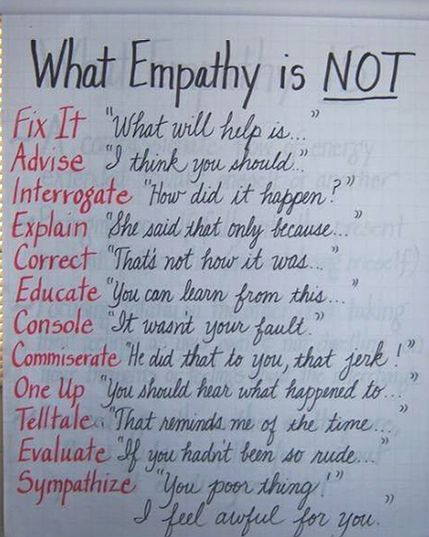What is Empathy?
Empathy is the ability to understand another person’s feelings, thoughts, and point of view.
One day, I was asked to observe a first-grade teacher. She was taking off for a couple of days, and I was asked to cover her class in her absence. She greeted her students with much enthusiasm; she had that “WOW” factor about herself. The first thing she did was smile as all the students stood up in anticipation. I didn’t know why but as soon as she turned on the music, the children shined like little lightning bugs. Everyone danced and chanted “Clap Clap Clap your hands.” I joined because the energy in Mrs. A’s was infectious! I love dancing to the Cha Cha slide, but I wondered why this activity was educational. Mrs. A explained that the song lyrics are a great way to teach her early learners the concept of left and right. As I watched her throughout the day, I thought “she is a master teacher.” Organized, knowledgeable and witty, but above all Mrs. A has a unique quality that is immeasurable.
In many cases, I have noticed this essential characteristic in most great educators. With great reflection, educators who consistently show empathy and have great emotion management skills are more influential in establishing spaces for authentic sharing and learning.
Here is why:
1. Empathy allows you to step in your students’ shoes. If you understand the needs, concerns, and triggers of your students, you can create an environment of learning and connection. While still being able to set boundaries and maintaining professionalism.
2. Empathy allowed the students to feel cared for and appreciated as individuals. Through compassion, staff can establish a caring and honest relationships. It is essential to hire people who are dedicated to modeling empathetic leadership.
3. Empathy reinforces community. In our ever-changing globalized world, children are learning how to create more productive relationships with people from different cultures and socioeconomic backgrounds. The effects of creating a culture of empathy in your programs will extend into the community. As a result, as staff model and teach compassion, students will model and show empathy, transferring their skills into their community.
What Now?
As I watched Mrs. A, she understood that the “How” you help children learn is more important than “What” is being taught. She empathized with her students by selecting a fun but educational tool that connects with first graders. This awareness is the mortar that holds in the bricks.
If you’d like to know more about integrating empathy into the culture of your programs check out the below resources.
Start Empathy- SEL Empathy Toolkit
https://startempathy.org/wp-content/uploads/2015/10/StartEmpathy_Toolkit.pdf
Karyn Gordon: Creating Empathy and Gratitude in the Classroom
http://www.teachmag.com/archives/1115
Bob Sornson: Developing Empathy in the Classroom
http://corwin-connect.com/2014/06/developing-empathy-classroom
What empathy Can Do
http://www.ascd.org/publications/educational-leadership/sept03/vol61/num01/What-Empathy-Can-Do.aspx

Tiana Brown is the Assistant Director of the Norwalk Housing Authority Learning Centers

